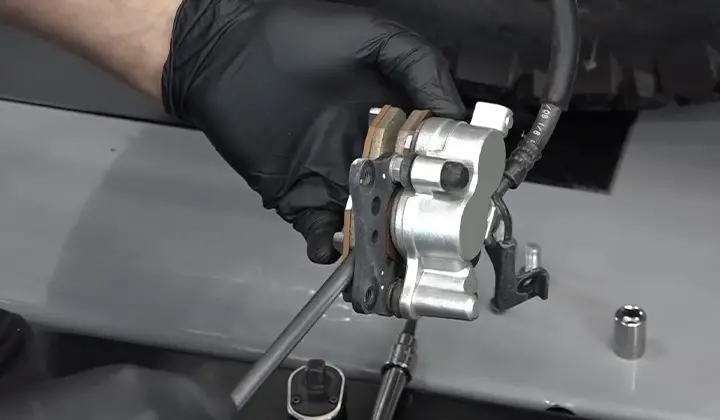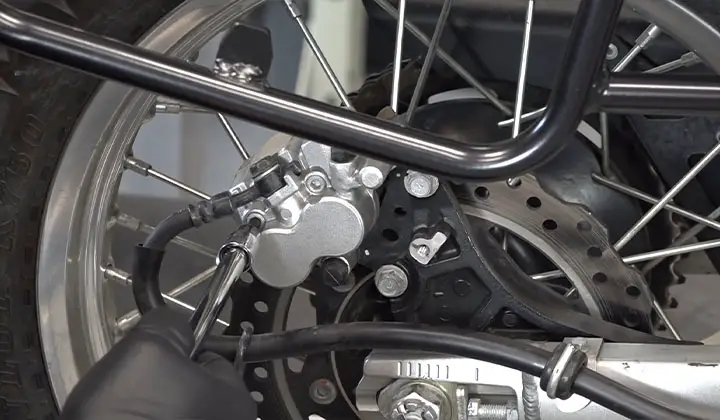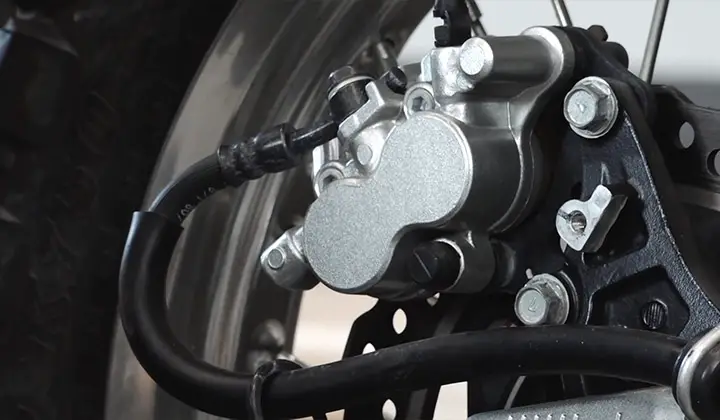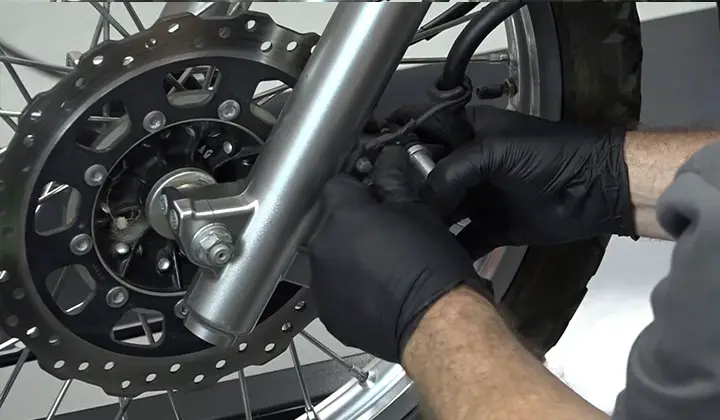There are several steps to follow when changing the brake pads on a KLR 650. Here are two sets of instructions: a popular one and an easy one that anyone can follow all by themselves.
Contents
The popular method
The rear brake pads removal and installation process are identical to the front. You can follow the same process when changing them.

Removing part
Let us begin on the front and remove the brake hose support to allow added more room to work when the caliper is removed.
Loosen the pins
Next, use a 5mm Allen wrench to loosen but do not remove the hex keyed alignment pins on the caliper. These can be tight and are easier to break free with the brake caliper that still has mounted on the fork.
Remove the bolts
Use a 12mm socket to remove the two caliper mounting bolts. Also, have a length of rope to support the caliper once it is removed from the fork.

Note
Do not let the caliper dangle by the brake hose.
Unscrew them
Now, the alignment pins that are holding the pads in the caliper are ready to come out. Use the Allen wrench to finish unscrewing them.
Note
But if they are stubborn about coming out, use a suitable tool to push them out from the backside.
Rotation part
When both pins are removed, the inside pad needs to rotate out and then the outside pad can be easily removed. That is all for taking things apart, the job is half done.
Brake pistons
Before installing the new pads, be sure to push the two brake pistons back into the cylinder bores.
Note
Because this makes more room for the thicker new pads to fit over the rotor when the caliper goes back on. The pistons can be moved by hand, but if they are stubborn you can use a C clamp to change the pads. Gently push the pads with the C-clamp back into the caliper.
Insert step
Insert the first pad against the pistons. Then partially insert both alignment pins through the caliper and the new pad.
Note
Give the pins a quick cleaning and inspection before inserting them.
Position the pads
There is a spring beneath both pads so apply slight downward pressure to align the pads with the pins. With the pins through the first pad, position the remaining pad and insert the pin through it and completely into the caliper.
Note
A couple of turns on the pin will hold it in place for now.
The thread locking
Next, position the caliper on the fork and reinstall the mount bolts. Be sure to use the thread locking compound on the threads and torque them down.
The brake hose
Apply locking compound on the exposed threads of the alignments pins and torque them down. Finally, reinstall the brake hose guide and remove the support rope from the caliper.
Easy process
The rear brake pads removal and installation are identical to the front and you can follow the same process when changing them. The rear brake pads and front brake pads removal system are slightly different compared to each other.
Tools
There are some tools we need to prepare beforehand. They are 3/8th ratchet, 8mm and 12mm sockets, a 5mm Allen, and a flat blade screwdriver.
Parts
There are two parts. One is Kawasaki KLR650 rear brake pads and another is Kawasaki KLR650 front brake pads. Both brake pads have a different changing process.
Replacing the Rear Brake Pads
Here, there will be a total of 11 steps that you need to follow. Some tips and notes will be also be added along with some steps.

The pads
First, remove the bracket near the rear caliper that holds the brake hose in place. Then break loose the two pins that hold the pads in place but do not remove them.
Tips
There is another way you can try. It is much easier to break these pins loose while the caliper is still attached to the motorcycle.
The caliper
Now remove the two bolts that hold the caliper on the motorcycle. This will allow you to lift the caliper away from the motorcycle. But be careful because the brake line is still attached.
Remove the pads
Then use a flat blade screwdriver to spread the pads apart. Now it is time to remove the pins that you broke loose in the pad-step. Once they are completely removed, you can lift the brake pads out of the caliper.
Tips
Even if they are new pads, you must follow this procedure. The point of spreading the pads is to make plenty of room for new pads with the thick braking material.
The inboard pad
Okey, Replace the rear brake pads but one at a time. Start with the inboard pad. Inboard means, the side of the caliper closest to the wheel of the motorcycle.
Note
This pad does not have a C-shaped hook. If you look down, there is a spring in the caliper. So, you will need to push down on the pad while pushing the pins into place.
The outboard pad
The outboard pad follows the same procedure. But except you will notice there is a C-shaped hook that goes around a corresponding round resting point. You have to slide the pins through these pads as well.
Tight the bolts
Now replace the caliper and tighten the two 12mm bolts that you have removed in the caliper part.
Final step
Secure the brake pads by tightening the two small Allen screws. Replace the bracket that holds the brake line, which was removed back in the beginning. Finally, pump the rear brake pedal a couple of times to get the pads to close in a little on the rotors and build pressure in the system.
Replace the Front Brake Pads
If you want to replace the fronts one then follow these steps.

Two 5mm Allens
The first thing you need to do is to break loose the two 5mm Allens that run through the brake pads.
Tips
You do not need to remove them yet, but they are easier to get loose while the caliper is still attached to the fork.
The brake pads
Try removing the 12mm bolts that are holding the caliper on the fork. This will allow you to lift the caliper away with the brake line still attached. Grab a flathead screwdriver and push the pads in and compress the brake pistons.
Now remove the two Allen screws that you have loosened in the beginning. This will enable you to lift out the brake pads. If there’s buildup on the pins, use a wire brush to clean them off a bit.
The inboard and outboard pad
First, position the inboard pad, then push against it to line up the holes so you can send the Allen screws through.
Then it is the same procedure for the outside pad, with the same C-shaped hook. Run the Allen screw through this outer pad as well and hand-tighten it.
Note
The procedure to replace the front brake pads is the same as in Steps 6-7 for the rear brake pads.
Last step
Now you can replace the brake caliper, and then replace and tighten the 12mm bolts that hold the caliper in place. Tighten the 5mm Allen screws that hold the pads in place. Finally, pump the brake lever a couple of times to build up brake pressure.
FAQ
1. Why are my brakes soft after changing pads?
Answer: Moisture in the fluid will not substantially change the pedal feel until the fluid temperature exceeds the boiling point of any water in the fluid, then the pedal feel gets very soft.
2. How long should I pump my brakes after changing pads?
Answer: This should take like 3-5 pumps on the pedal max, not 5 minutes of pumping.
Conclusion
Changing brake pads at home is very easy. All you need is the required tools and follow the steps. You can follow the popular procedure as everyone does.
